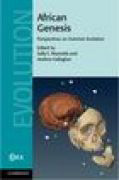
African genesis: perspectives on hominin evolution
Reynolds, Sally C.
Gallagher, Andrew
Reviews key themes and developments in palaeoanthropology, exploring their impact on our understanding of human origins in Africa. Exploring developmentsin palaeoanthropology since the discovery of Australopithecus Africanus in 1924, this book is a valuable companion for students and researchers of human origins. It covers a range of key themes, from the earliest hominin fossils, to the origins of bipedalism and the evolution and dispersal of modern humans. Exploring developments in palaeoanthropology since the discovery of Australopithecus Africanus in 1924, this book is a valuable companion for students and researchers of human origins. It covers a range of key themes, from the earliest hominin fossils, to the origins of bipedalism and the evolution and dispersal of modern humans. The discovery of the first species of African hominin, Australopithecus Africanus, from Taung, South Africa in 1924, launched the study offossil man in Africa. New discoveries continue to confirm the importance of this region to our understanding of human evolution. Outlining major developments since Raymond Dart's description of the Taung skull and, in particular, theimpact of the pioneering work of Phillip V. Tobias, this book will be a valuable companion for students and researchers of human origins. It presents a summary of the current state of palaeoanthropology, reviewing the ideas that are central to the field, and provides a perspective on how future developments will shape our knowledge about hominin emergence in Africa. A wide range of key themes are covered, from the earliest fossils from Chad and Kenya, to the origins of bipedalism and the debate about how and where modern humans evolved anddispersed across Africa. INDICE: List of contributors; Foreword J. T. Francis Thackeray; 1. Africangenesis: an evolving paradigm Sally C. Reynolds; 2. Academic genealogy Peter Ungar and Phillip V. Tobias; Part I. In Search of Origins: Evolutionary Theory, New Species, and Paths into the Past: 3. Speciation in hominin evolution Colin Groves; 4. Searching for a new paradigm for hominid origins in Chad (Central Africa) Michel Brunet; 5. From hominoid arboreality to hominid bipedalism Brigitte Senut; 6. Orrorin and the African ape/hominid dichotomy Martin Pickford; 7. A brief history and results of 40 years of Sterkfontein excavations Ronald J. Clarke; Part II. Hominin Morphology Through Time: Brains, Bodies and Teeth: 8. Hominin brain evolution, 1925–2011: an emerging overview Dean Falk; 9.The issue of brain reorganisation in Australopithecus and early hominids: Dart had it right Ralph L. Holloway; 10. The mass of the human brain: is it a spandrel? Paul R. Manger, Jason Hemingway, Muhammad Spocter and Andrew Gallagher;11. Origin and diversity of early hominin bipedalism Henry M. McHenry; 12. Forelimb adaptations in Australopithecus afarensis Michelle S. M. Drapeau; 13. Hominin proximal femur morphology from the Tugen Hills to Flores Brian G. Richmond and William L. Jungers; 14. Daily rates of dentine formation and root extension rates in Paranthropus boisei, KNM-ER 1817, from Koobi Fora, Kenya M. Christopher Dean; 15. On the evolutionary development of early hominid molar teeth and the Gondolin Paranthropus molar Kevin L. Kuykendall; 16. Digital South African fossils: morphological studies using reference-based reconstruction andelectronic preparation Gerhard W. Weber, Philipp Gunz, Simon Neubauer, Philipp Mitteroecker and Fred L. Bookstein; Part III. Modern Human Origins: Patterns, and Processes: 17. Body size in African Middle Pleistocene Homo Steven E. Churchill, Lee R. Berger, Adam Hartstone-Rose and Headman Zondo; 18. The Africanorigin of recent humanity Milford H. Wolpoff and Sang-Hee Lee; 19. Assimilation and modern human origins in the African peripheries Fred H. Smith, Vance T.Hutchinson and Ivor Janković; 20. Patterns of Middle Pleistocene hominin evolution in Africa and the emergence of modern humans Emma Mbua and Günter BrÃñuer; 21. Integration of the genetic, anatomical, and archaeological data for the African origin of modern humans: problems and prospects Osbjorn M. Pearson;Part IV. In Search of Context: Hominin Environments, Behaviour and Lithic Cultures: 22. Animal palaeocommunity variability and habitat preference of robustaustralopiths in South Africa Darryl J. de Ruiter, Matt Sponheimer and Julia Lee-Thorp; 23. Impacts of environmental change and community ecology on the composition and diversity of the southern African monkey fauna from the Plio-Pleistocene to the present Sarah Elton; 24. African genesis revisited: reflections on Raymond Dart and the 'Predatory Transition from Ape(-Man) to Man' Travis R. Pickering; 25. Shared intention in early artefacts: an exploration of deep structure and implications for communication and language John A. J. Gowlett; 26. Sibudu Cave: recent archaeological work on the Middle Stone Age Lyn Wadley; 27. The oldest burials and their significance Avraham Ronen; Index.
- ISBN: 978-1-107-01995-9
- Editorial: Cambridge University
- Encuadernacion: Cartoné
- Páginas: 598
- Fecha Publicación: 29/03/2012
- Nº Volúmenes: 1
- Idioma: Inglés
